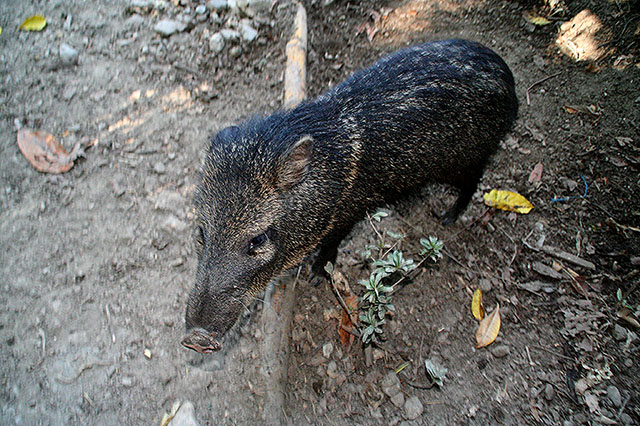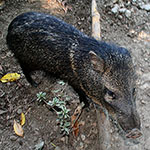- Home
- Accommodation
- Activities
- Area Info
- Maps
- Photo Galleries
- Real Estate
- Travel
Peccary
Found In: The peccary is a pig like animal that is found mainly in the forests of North America and throughout Central and South America. The colored peccaries resemble javelins. They are much more common than the white-lipped peccary found in Costa Rica’s dry tropical forest.
Size: They normally measure 90 to 130 cm (3-4.3 ft). It is about 20 in (50 cm) high at the shoulder and weighs about 50 lb (23 kg).
Weight: An adult Peccary is weighs anywhere between 20-40 kg (44-88 lb).
Average life span: Experts believe that wild collared peccaries can survive up to sixteen years, but a small number of peccaries live beyond eight years.
 The peccary, also known as the skunk pig, or the javelina, is classified as a mammal of the Tayassuidae family, found solely in the Americas including various regions of Costa Rica. These midsized creatures bear a striking resemblance to pigs and also belong to the same animal familia. They are in fact often confused with pigs. Like regular pigs, peccaries too sport a round snout and tiny eyes.
The peccary, also known as the skunk pig, or the javelina, is classified as a mammal of the Tayassuidae family, found solely in the Americas including various regions of Costa Rica. These midsized creatures bear a striking resemblance to pigs and also belong to the same animal familia. They are in fact often confused with pigs. Like regular pigs, peccaries too sport a round snout and tiny eyes.
Collared peccaries generally inhabit thick forests and second-growth jungles, and prefer areas that are located near water bodies. They move around in groups of up to 30 peccaries, and their home range goes on till about 300 acres. Colored peccary’s species are intensely territorial by nature and hence the groups almost always never overlap.
The adult peccary weighs anywhere between 20-40 kilos, and averages at 90-130 cm in length. Peccaries are hunted for food and their skin. When born, they are reddish brown in color, but by adulthood they acquire gray-black skin enclosed in rough hair that can be as lengthy as 15.2 cm on the back. A prominent white strip around the neck distinguishes them as “collared.’ With their agile, lengthy snouts, they dig the earth, forage on fallen fruit, and other parts of a plant. There are two peccary species found in Costa Rica, which are generally spotted in groups -the White-Lipped Peccaries and the Collared Peccaries.
The female gestational period lasts less than 5 months, and female peccaries give birth to 1-5 babies, out of which only two births are normal. The Costa Rican Collared peccaries are born with beige or chestnut coat coloring, and are capable of running within hours of birth. Young peccaries nurse for about 6-8 weeks, and are completely on their own within three months of birth. Female peccaries reach sexual maturity by one year.
The peccaries are extremely social mammals and stay in groups of 3 to 30 or more. The group size is most likely to stay between 2 and 15 in Costa Rica. They have an interesting greeting ritual. Each peccary will rub its head on the scent gland on the back of the other. All Peccaries make vocalizations to communicate among themselves, like a loud bark, aggressive grumblings while feeding and tooth chattering. Their most aggressive disputes are over watering holes in forests in dry weather.
 A peccary inhabits tropical deciduous forests, scrub forests, semi-desert regions, and tropical rainforests, making it a versatile and omnipresent across the Americas. The peccary’s diet is primarily vegetarian as well as non-vegetarian, making them omnivores. Their stomach has 3 compartments which makes its eating habits more erratic and complicated than those of the pig. They prefer to eat different parts of a plant and small fruits. They especially enjoy eating their cacti, but also thrive on dead animals and insects. Unlike pigs however, the peccary are wilder and it is a challenge to domesticate them.
A peccary inhabits tropical deciduous forests, scrub forests, semi-desert regions, and tropical rainforests, making it a versatile and omnipresent across the Americas. The peccary’s diet is primarily vegetarian as well as non-vegetarian, making them omnivores. Their stomach has 3 compartments which makes its eating habits more erratic and complicated than those of the pig. They prefer to eat different parts of a plant and small fruits. They especially enjoy eating their cacti, but also thrive on dead animals and insects. Unlike pigs however, the peccary are wilder and it is a challenge to domesticate them.
They often attack humans when confronted and are capable of causing a lot of havoc. Peccaries are social animals and as such will also attack in groups, hurting human beings. They also feed on rice fields and corn due to which they are attacked by farmers in addition to being tracked down for their much in demand hide. They are also widely hunted by predators such as pumas, bobcats and jaguars. In spite of their reputation of being aggressive, peccaries rarely pose a threat. Although they are of big in size and cannot do much damage with their tusks, they rarely attack. The best way to avoid a confrontation with them is to be quiet and let them be since they are not known to have good eyesight.
Further Reading
http://www.costaricajourneys.com/peccaries/
http://www.travelcostarica.nu/mammals
http://costarica.com/wildlife/collared-peccaries/
Great Stuff

Clandestina Restaurant
My new favorite restaurant, Clandestina is not to be missed by food lovers staying anywhere near to Montezuma. Established in March 2015, Clandestina is the new kid on the block. The Oregon/Tico collaboration is a winner among locals and travelers alike, with artisan craft beers, made onsite by Butterfly Brewing Co. and delicious, exciting […]











